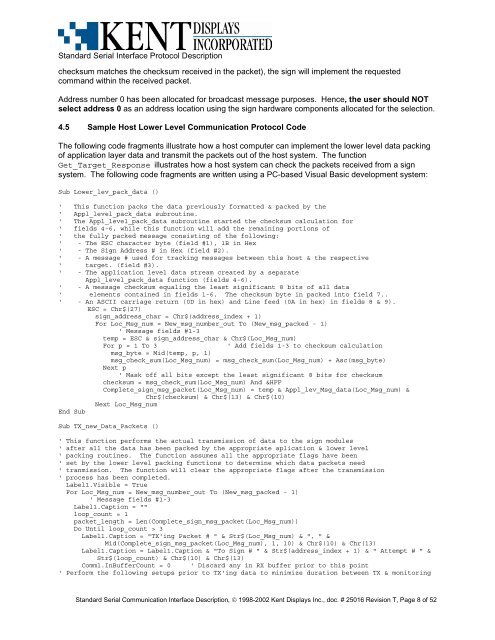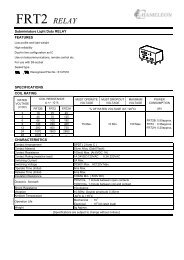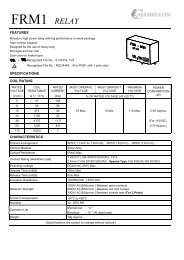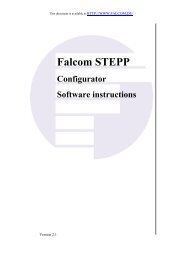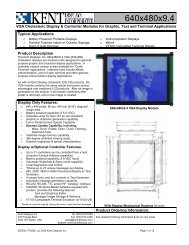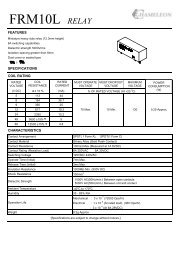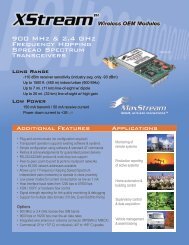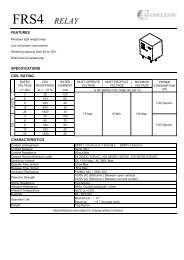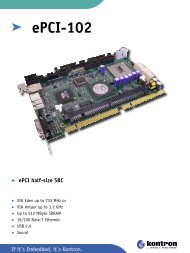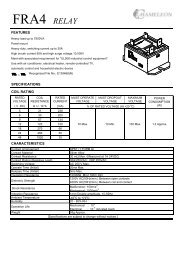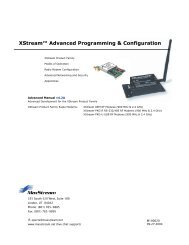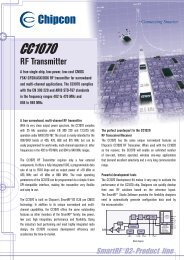STANDARD SERIAL COMMUNICATION INTERFACE and ...
STANDARD SERIAL COMMUNICATION INTERFACE and ...
STANDARD SERIAL COMMUNICATION INTERFACE and ...
You also want an ePaper? Increase the reach of your titles
YUMPU automatically turns print PDFs into web optimized ePapers that Google loves.
St<strong>and</strong>ard Serial Interface Protocol Description<br />
checksum matches the checksum received in the packet), the sign will implement the requested<br />
comm<strong>and</strong> within the received packet.<br />
Address number 0 has been allocated for broadcast message purposes. Hence, the user should NOT<br />
select address 0 as an address location using the sign hardware components allocated for the selection.<br />
4.5 Sample Host Lower Level Communication Protocol Code<br />
The following code fragments illustrate how a host computer can implement the lower level data packing<br />
of application layer data <strong>and</strong> transmit the packets out of the host system. The function<br />
Get_Target_Response illustrates how a host system can check the packets received from a sign<br />
system. The following code fragments are written using a PC-based Visual Basic development system:<br />
Sub Lower_lev_pack_data ()<br />
' This function packs the data previously formatted & packed by the<br />
‘ Appl_level_pack_data subroutine.<br />
' The Appl_level_pack_data subroutine started the checksum calculation for<br />
‘ fields 4-6, while this function will add the remaining portions of<br />
' the fully packed message consisting of the following:<br />
' - The ESC character byte (field #1), 1B in Hex<br />
' - The Sign Address # in Hex (field #2).<br />
' - A message # used for tracking messages between this host & the respective<br />
‘ target. (field #3).<br />
' - The application level data stream created by a separate<br />
Appl_level_pack_data function (fields 4-6).<br />
' - A message checksum equaling the least significant 8 bits of all data<br />
‘ elements contained in fields 1-6. The checksum byte in packed into field 7..<br />
' - An ASCII carriage return (0D in hex) <strong>and</strong> Line feed (0A in hex) in fields 8 & 9).<br />
ESC = Chr$(27)<br />
sign_address_char = Chr$(address_index + 1)<br />
For Loc_Msg_num = New_msg_number_out To (New_msg_packed - 1)<br />
' Message fields #1-3<br />
temp = ESC & sign_address_char & Chr$(Loc_Msg_num)<br />
For p = 1 To 3<br />
' Add fields 1-3 to checksum calculation<br />
msg_byte = Mid(temp, p, 1)<br />
msg_check_sum(Loc_Msg_num) = msg_check_sum(Loc_Msg_num) + Asc(msg_byte)<br />
Next p<br />
' Mask off all bits except the least significant 8 bits for checksum<br />
checksum = msg_check_sum(Loc_Msg_num) And &HFF<br />
Complete_sign_msg_packet(Loc_Msg_num) = temp & Appl_lev_Msg_data(Loc_Msg_num) &<br />
Chr$(checksum) & Chr$(13) & Chr$(10)<br />
Next Loc_Msg_num<br />
End Sub<br />
Sub TX_new_Data_Packets ()<br />
' This function performs the actual transmission of data to the sign modules<br />
' after all the data has been packed by the appropriate aplication & lower level<br />
' packing routines. The function assumes all the appropriate flags have been<br />
' set by the lower level packing functions to determine which data packets need<br />
' tranmission. The function will clear the appropriate flags after the transmission<br />
' process has been completed.<br />
Label1.Visible = True<br />
For Loc_Msg_num = New_msg_number_out To (New_msg_packed - 1)<br />
' Message fields #1-3<br />
Label1.Caption = ""<br />
loop_count = 1<br />
packet_length = Len(Complete_sign_msg_packet(Loc_Msg_num))<br />
Do Until loop_count > 3<br />
Label1.Caption = "TX'ing Packet # " & Str$(Loc_Msg_num) & ", " &<br />
Mid(Complete_sign_msg_packet(Loc_Msg_num), 1, 10) & Chr$(10) & Chr(13)<br />
Label1.Caption = Label1.Caption & "To Sign # " & Str$(address_index + 1) & " Attempt # " &<br />
Str$(loop_count) & Chr$(10) & Chr$(13)<br />
Comm1.InBufferCount = 0 ' Discard any in RX buffer prior to this point<br />
' Perform the following setups prior to TX'ing data to minimize duration between TX & monitoring<br />
St<strong>and</strong>ard Serial Communication Interface Description, © 1998-2002 Kent Displays Inc., doc. # 25016 Revision T, Page 8 of 52


